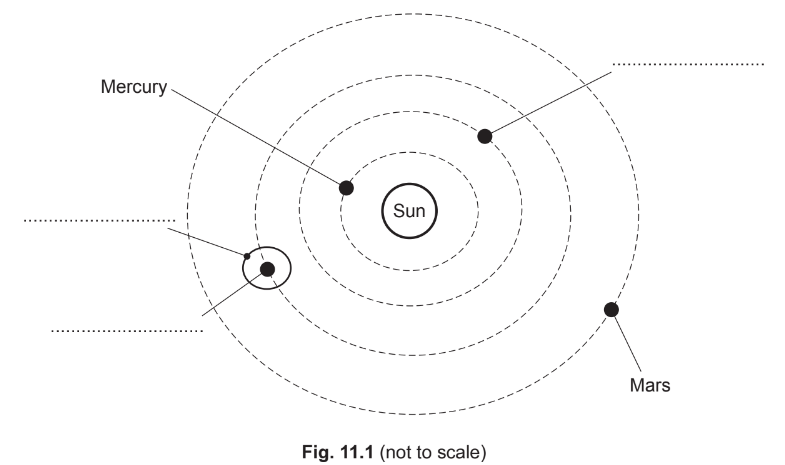Question
Fig. 11.1 shows the Sun and the four innermost planets, A, B, C, and D, of the Solar System.

(a) In Table 11.1, write the names of the innermost planets. One is done for you.

(b) Describe how the four innermost planets of the Solar System were formed.
…………………………………………………………………………………………………………………………………
…………………………………………………………………………………………………………………………… [4] [Total: 6]
▶️Answer/Explanation
Ans:
(a) Mercury Venus Earth Mars
(b)
dust and gas (clouds orbit the Sun)
contain many different elements
rotation of material (around Sun)
(leads to) particles accrete / combine / join
(subsequently) forming larger rocks / boulders
(because of) gravitational attraction
material moves to form (protoplanetary) disks (orbiting Sun)
(continued collisions lead to) formation of planetary core
Question
There are eight planets in our Solar System.
Table 12.1 shows the names of some of the planets in order of distance from the Sun.
(a) Complete Table 12.1 by writing the names of the other planets in order of increasing distance from the Sun.\([2]\)
(b) The planets in Table 12.1 orbit the Sun.
State the names of two other types of natural object that orbit the Sun.
1…………………………………..
2………………………………….\([2]\)
(c) Complete the sentences to describe Mercury and Jupiter. Use words from the list.
large rocky gaseous small liquid
Mercury ………………is………………………and………………
Jupiter………………is………………………and……………… [2]
▶️Answer/Explanation
Ans:
(a) at least 4 named
all 5 in correct order
(b) any two from:
minor / dwarf planets / Pluto
asteroids
comets
moons / natural satellites
(c) Mercury is rocky AND small. (answers maybe in either order)
Jupiter is gaseous AND large. (answers maybe in either order)
Question
Fig. 11.1 represents the Sun and part of the Solar System.

(a) Complete the labels on Fig. 11.1 by writing on the dotted lines. [3]
(b) Complete the sentences about the Sun.
The Sun consists mostly of the elements ………………………………………………………………. and
………………………………………………………………. .
Most of the Sun’s energy is radiated in the infrared, ………………………………………………………..
and ………………………………………………………………. regions of the electromagnetic spectrum. [4]
(c) Give an estimate for the diameter of the Milky Way galaxy.
diameter = ………………………………… light-years [1] [Total: 8]
▶️Answer/Explanation
Ans:

11(b) Hydrogen and
Helium (answers maybe in either order)
visible (light) and
Ultraviolet (answers maybe in either order)
11(c) 100 000 (light-years)
